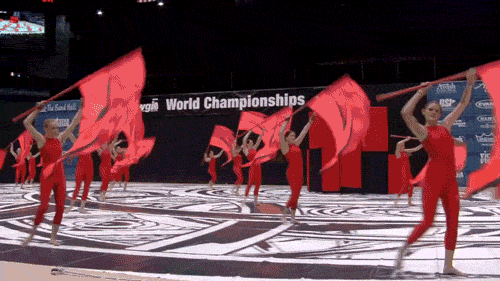We’ve all seen it at marching band and winter guard competitions – a rifle or flag flies through the air. The audience takes an alarming gasp as they can tell the weapon isn’t going to land where it was intended to. Even worse than a bad toss – the weapon nails an unsuspecting performer in head.
Dazed, the performer glances around trying to figure out what happened, while also struggling to resume performing the show. At the end of the performance we see that same injured performer wandering off the floor in a mental fog. It’s a picture we remember at the end of the show, and having concerned conversation with other staff members, parents, and students about. But what are we DOING about it?

Concussions might be as problematic in an activity like color guard as they are in contact sports, like football. Performers with a history of concussions have a higher risk of sustaining recurrent concussions. Yet, there is little to no attention drawn to it or education for staff and students on the topic. Here are three keys to understanding the concussion problem in color guard.
- Concussions are a mild traumatic brain injury.
Concussions are typically caused by a blow to the head, and have deeper injury than what we are able to visualize from surface level. The American Academy of Neurology defines concussions as “trauma-induced alteration of brain function, typically affecting memory and orientation, which may involve loss of consciousness (LOC)”. Concussions impact the brain on a cellular level and must be treated accordingly.
- Concussions DO NOT require a loss of consciousness.
While losing consciousness can help you identify students who most likely do have a concussion, a loss of consciousness is not necessary to sustain a concussion. If you are worried that a student may have a concussion, MAKE SURE the student is evaluated by your school’s athletic trainer, physician, or a specialist trained in concussion management – such as a neurologist. This will either rule out the presence of a concussion, or help concussed performers get started on the road to recovery and return to activity safely.
This also impacts how we approach helping a student recover from a concussion. Each concussion is different, and must be treated individually. Symptoms of headaches, fatigue, and mental focus can all be impacted by the demands of marching band and color guard. Bright lights and loud music often exacerbate concussion symptoms. Returning a student to practice and performing should be done methodically, and with medical supervision. Concussed students should never return to performing the same day the injury occurred, and should follow their school’s or physician’s “Return to Play” protocol.
- Concussions can be PREVENTED.
We do need to assess safety in regards to progressing teaching color guard weapons skills and show demand. One of the most common problems we see is progressing tossing skills too quickly without proper precautions for injury. A simple recommendation is to have helmets available to beginner students who may not be comfortable with a new skill. Bicycle or skateboarding helmets are appropriate and affordable to help ensure student safety.
Show demand and design should also take into consideration student health and injury risk. “Big moments” of shows often get the bulk of our attention during both designing the show and rehearsing it. However, the transitions into and out of these critical show moments oftentimes do not get the same amount of attention. These moments of shows that may not appear as risky can often be the spots where students do not have ideal spacing in the drill, or do not get the number of reps they need to execute the show section as safely as an impact moment.
As you go into your winter season please consider the performance demands on students from a health and injury prevention perspective as much as from a musical or movement skills perspective. This can make a significant impact on reducing the prevalence of concussions and all injuries in the marching arts.
References:
- Journal of Athletic Training 2014;49(2):245–265 position statement doi: 10.4085/1062-6050-49.1.07
- American Academy of Neurology. Position Statement: Sports Concussion

